MSU Experts Make Tarnished Plant Bug Recommendations
MISSISSIPPI STATE, MISS.
New research shows potential for offering new strategies to limit
tarnished plant bug damage in cotton, but sure options already exist.
Mississippi State University scientists and Extension specialists
have compiled decades of research to create a comprehensive
recommendation for dealing with tarnished plant bugs in cotton.
Angus Catchot, MSU Extension row-crops entomologist, said tarnished
plant bugs have been a problem for years, and their resistance to
insecticides has increased over time. These insects are direct pests of
cotton and feed on the flower bud, called a square, causing it to drop
from the plant. Yield losses can be very high under heavy pressure.
Mississippi producers have moved away from planting cotton in favor
of grains in recent years. Catchot said this decrease in acres makes the
problem worse because plant bugs typically develop on other hosts and
move into cotton.
“When cotton acres are low, you have the same numbers developing and
moving into fewer acres, which can intensify the problems,” Catchot
said. “We’ve developed a multi-tactical approach designed to break the
tarnished plant bug’s reproductive cycle, decrease damage, and better
manage cotton crops based on scientific experiments and what we’ve seen
work over the years.”
Earliness …
Planting the cotton crop earlier is Catchot’s first recommendation.
“As planting dates get later, tarnished plant bug populations increase
and develop tolerance for the pesticide chemistries,” he said. “Variety
selection, in terms of early-maturing varieties, helps manage for
earliness and increases yields.”
Location …
Cotton producers should also consider the crops that are planted
around cotton fields. Producers can keep insect numbers down by blocking
cotton away from other crops, especially corn, to discourage migration
into cotton.
Mixtures …
Catchot said MSU researchers found that currently available
foliar-applied pesticides produce marginal results. Only a limited
number of pesticides are effective at all, so using recommended tank
mixtures is important in managing tarnished plant bug populations.
Growth regulation …
“We recommend earlier use of Diamond insecticide, during the third
week of squaring,” he said. “Diamond is an insect growth regulator and
has activity only on nymphs. The third week of squaring is generally the
time we start seeing the first nymphs in cotton. When Diamond is
applied at this stage, eggs hatch into the residual insecticide, and
nymphs are controlled at their most susceptible state, first instars.”
Host management …
The insects overwinter as adults outside the field and quickly invade
broadleaf plants before migrating into cotton fields in early spring.
Catchot recommended timely ditch and field bank management to eliminate
the wild hosts on which insects develop before they invade cotton.
“Keep the field margins mowed early and keep them from flowering to
discourage large populations of tarnished plant bugs,” he said.
Pesticide application frequency …
During times of heavy pressure, Catchot recommended decreasing the
time between sprays to help break the pest’s reproductive cycle.
“Two back-to-back applications, even at lower rates, is always better
than a single application during heavy pressure times of the season,”
he said.
Variety selection …
Jeff Gore, entomologist with the Mississippi Agricultural and
Forestry Experiment Station at the Delta Research and Extension Center
in Stoneville, said scientists have found that leaf hairiness may affect
tarnished plant bug populations.
In initial experiments, smooth-leaf varieties lost squares, while
hairy leaf varieties did not have as much damage, Gore said.
“Interestingly, we found more bugs in the hairy leaf varieties, but
bug numbers can be deceiving,” he said. “The evidence in the field was
almost shocking to see, in terms of bolls evident in the hairy-leaf
varieties compared to the low numbers of bolls in the smooth-leaf
varieties.”

A test plot of a smooth-leaf
cotton variety, right, planted next to a test plot of a hairy-leaf
cotton variety, left, at the Mississippi State University Delta Research
and Extension Center in Stoneville shows the impact of tarnished plant
bugs on cotton yields.
Photo courtesy of Wilks Wood
Gore said that the expense of the chemicals used to control tarnished plant bugs is not sustainable.
“We want to tie together all of these different management practices
into a solid recommendation to reduce management costs for the
producers, but also to reduce the amount of chemicals used,” Gore said.
“But to get cotton acres back in the Delta, we need a different type of
technology.”
Historically, genetically modified cotton has successfully reduced
the impact of targeted insect pests. For example, Bollgard cotton
produces a toxin specific to caterpillar pests, such as the boll worm or
tobacco budworm.
“Tobacco budworm was resistant to all insecticides, and we had a huge
outbreak in 1995 that resulted in a lot of money spent on foliar
insecticides,” Gore said. “Bollgard cotton came out in 1996, and we have
not had to spray a single Bollgard field since that time for tobacco
budworm. Now we’re at that stage with tarnished plant bugs.
“We need a technology similar to Bollgard cotton that controls
tarnished plant bugs to provide enough incentive for growers to start
planting more cotton in the Mississippi Delta,” he said.∆